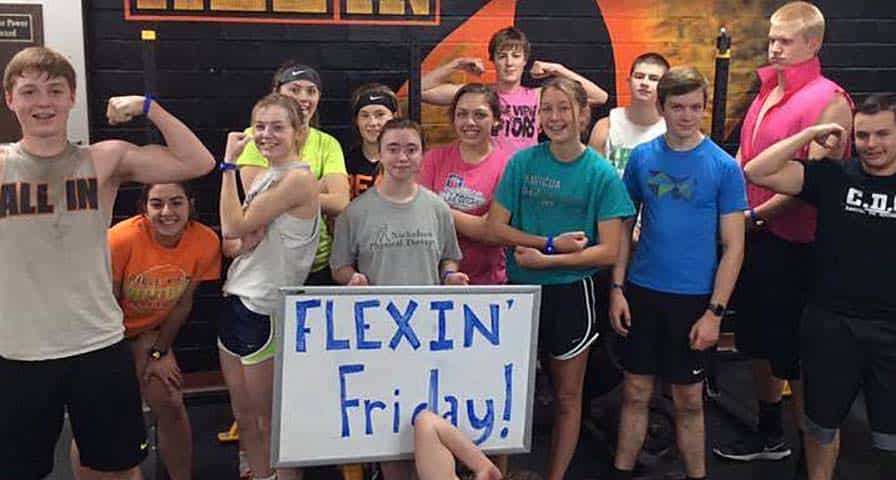Jan. 26, 2017 – Ridge View (Holstein, Iowa) High School physical educators Justin Kinney and Matt Best introduced IHT Zone heart rate monitors to their physical education classes in December, hoping to motivate students they feared simply went through the motions during class.
One month later, any concerns the teachers had about student motivation have vanished.
“I have been really surprised with how well they’ve taken to it and how it has motivated them,” Kinney said. “In the past, these are kids who were not reaching their potential, and those have been the kids who have hit their Zone goals every single day. It’s been visibly noticeable, that just by even having the monitor on, they take it up another notch in their training.”
Motivated by monitors
Kinney and Best combine to teach two types of physical education classes: a strength and conditioning class made up mostly of athletes and a traditional PE class where students hadn’t previously shown much enthusiasm for exercise. While they’ve seen improved results in both classes, the regular PE students have performed better than the teachers expected.
After wearing the Zone monitors during class, students are eager to review their individual reports generated by the Spirit Heart Rate Monitor software. Students see how long they worked out in each heart rate zone (blue, yellow or red) and whether they achieved that day’s goal.
“There are quite a few kids that are excited who, once they are done with that day’s activity, they jog or sprint over to the computer to log out and see where they were at,” Best said. “For them, it’s the motivation and the impact and they can really say, ‘Oh man, I worked really hard today.’”
Students aren’t just running over to the computer to return their monitor at the end of class. One student’s effort caught Ridge View Principal Bret Warnke’s attention.
“The other day our principal came running into the weight room,” Kinney said. “He asked if there was an emergency, and I said, ‘No, why?’ And he pointed out that student and said, ‘Well, he was just sprinting through the lunch room and we were worried and thought something might be wrong.’”
Just minutes earlier, the unnamed student had asked permission to visit the restroom. Not to worry, Kinney told his concerned principal.
“He was running because he wanted to get back to his workout so he could keep his heart rate up.”
Individualized goals for best results
Kinney became drawn to the Spirit System’s student-to-student flexibility in assessing student PE performance. He can set a goal for the class to meet, but he can also set goals for each student based on their personal needs.
“You have the kid who’s a multiple-time state qualifier in track and field and a kid who’s never worked out a day in his life,” he said. “The biggest thing I’ve learned is how to adjust the goals from student to student based on where they are, where they’re going and what they need.”
Both teachers understand that each student will need to take these lessons with them after graduation. The Spirit HRM reports tell both student and teacher if what the student felt during the workout translated into the data. If a student felt he worked harder than the data showed, Kinney said the data opens a door to a larger conversation.
“There have been some discussions when kids haven’t met their goals,” he said. “They would insist they work hard, and then we’d sit down and visit about the effort needed to meet their goals.”
Turning assessments into life lessons
With the report at their fingertips, Best and Kinney can either agree with that student’s sentiment or not, and they can do it objectively without losing sight of the big picture.
“One thing that I wanted to do better was to assess PE better,” Kinney said. “At the same time, the focus is on the students, not for them to get a good grade or be assessed better.”
Between them, Kinney and Best work with 200 motivated students through physical education, half in a traditional PE class and half through a more rigorous strength and conditioning program. The students in the strength and conditioning class represent the more athletic students and the PE class is more reflective of the overall student body. Their goal for all of their students remains consistent.
“Our goal is not to just to get these kids in and out of class,” Best said. “We want to teach them how to be active after high school, not just sit on the couch and eat bon-bons or potato chips. We want to give these kids the opportunity to understand more about their bodies to the extent that they can now use [their knowledge] after education.”
Best and Kinney have been pleased with how motivated their students have been beginning their journey with the IHT Spirit System and can’t wait to see how students progress as they get more familiar with their data and what it teaches them.
“The sky’s the limit with how and where we want to go with it,” Kinney said.


